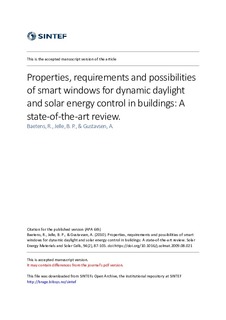| dc.contributor.author | Baetens, Ruben | |
| dc.contributor.author | Jelle, Bjørn Petter | |
| dc.contributor.author | Gustavsen, Arild | |
| dc.date.accessioned | 2017-12-30T00:13:19Z | |
| dc.date.available | 2017-12-30T00:13:19Z | |
| dc.date.created | 2009-12-22T17:40:51Z | |
| dc.date.issued | 2010 | |
| dc.identifier.citation | Solar Energy Materials and Solar Cells. 2010, 94 (2), 87-105. | nb_NO |
| dc.identifier.issn | 0927-0248 | |
| dc.identifier.uri | http://hdl.handle.net/11250/2473860 | |
| dc.description.abstract | A survey on prototype and currently commercial dynamic tintable smart windows has been carried out. The technologies of electrochromic, gasochromic, liquid crystal and electrophoretic or suspended-particle devices were examined and compared for dynamic daylight and solar energy control in buildings. Presently, state-of-the art commercial electrochromic windows seem most promising to reduce cooling loads, heating loads and lighting energy in buildings, where they have been found most reliable and able to modulate the transmittance up to 68% of the total solar spectrum. Their efficiency has already been proven in hot Californian climates, but more research is necessary to validate the products for colder climates, and to improve furthermore the commercial products in order to control the indoor climate in a more energy efficient way by reducing both heating and cooling loads | nb_NO |
| dc.description.sponsorship | Acknowledgements. This work was supported by the Research Council of Norway, AF Gruppen, Glava, Hunton Fiber as, Icopal, Isola, Jackon, maxit, Moelven ByggModul, Rambøll, Skanska, Statsbygg and Takprodusentenes forskningsgruppe through the SINTEF/NTNU research project ‘Robust Envelope Construction Details for Buildings of the 21st Century’ (ROBUST). | nb_NO |
| dc.language.iso | eng | nb_NO |
| dc.publisher | Elsevier | nb_NO |
| dc.rights | Attribution-NonCommercial-NoDerivatives 4.0 Internasjonal | * |
| dc.rights.uri | http://creativecommons.org/licenses/by-nc-nd/4.0/deed.no | * |
| dc.subject | Transparent conductor | nb_NO |
| dc.subject | Gasochromic window | nb_NO |
| dc.subject | Liquid crystal window | nb_NO |
| dc.subject | Smart window | nb_NO |
| dc.subject | Electrochromic window | nb_NO |
| dc.subject | Suspended-particle window | nb_NO |
| dc.subject | Electrophoretic window | nb_NO |
| dc.subject | Daylight control | nb_NO |
| dc.subject | Solar energy control | nb_NO |
| dc.title | Properties, Requirements and Possibilities of Smart Windows for Dynamic Daylight and Solar Energy Control in Buildings: A State-of-the-Art Review | nb_NO |
| dc.type | Journal article | nb_NO |
| dc.type | Peer reviewed | nb_NO |
| dc.description.version | acceptedVersion | nb_NO |
| dc.rights.holder | © 2010 Elsevier. All rights reserved. This is the authors' accepted and refereed manuscript to the article, post-print. Released with a Creative Commons Attribution Non-Commercial No Derivatives License. The final publication is available at https://doi.org/10.1016/j.solmat.2009.08.021 | nb_NO |
| dc.subject.nsi | VDP::Technology: 500 | nb_NO |
| dc.source.pagenumber | 87-105 | nb_NO |
| dc.source.volume | 94 | nb_NO |
| dc.source.journal | Solar Energy Materials and Solar Cells | nb_NO |
| dc.source.issue | 2 | nb_NO |
| dc.identifier.doi | 10.1016/j.solmat.2009.08.021 | |
| dc.identifier.cristin | 500763 | |
| cristin.unitcode | 7401,30,40,0 | |
| cristin.unitname | Arkitektur, byggematerialer og konstruksjoner | |
| cristin.ispublished | true | |
| cristin.fulltext | original | |
| cristin.fulltext | postprint | |
| cristin.qualitycode | 2 | |

